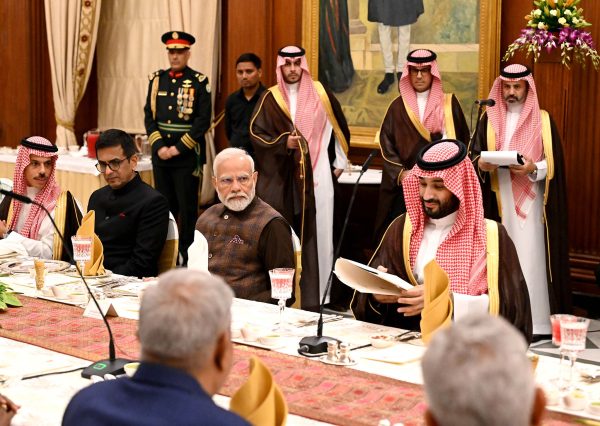One achievement reached on the sidelines of India’s G-20 Summit was the new initiative to develop a rail and shipping corridor connecting India to Europe via the Middle East. According to a White House fact sheet, leaders from the United States, India, Saudi Arabia, the United Arab Emirates, France, Germany, Italy, and the European Union signed a Memorandum of Understanding (MoU) agreeing to establish a new India-Middle East-Europe Economic Corridor (IMEC).
That some of the major Middle Eastern countries including Saudi Arabia, Israel, the UAE, and Jordan are part of it makes it noteworthy, especially from a geopolitical perspective. Announcing this at the G-20 Leaders’ meeting on the Partnership for Global Infrastructure and Investment (PGII), the leaders noted that the IMEC will involve rail connectivity, shipping lines, high-speed data cables, and energy pipelines. These will complement the existing maritime and road networks that will enhance movement of trade and services “to transit to, from, and between India, the UAE, Saudi Arabia, Jordan, Israel, and Europe.”
Especially since China launched its Belt and Road Initiative (BRI), the United States and its partners have made efforts to come up with effective alternative proposals. The PGII, launched as a counter to China’s BRI at the G-7 Summit in August 2022, is also an infrastructure initiative to fund connectivity projects in developing countries. Like IMEC, the PGII has four focus areas: health and health security, digital connectivity, gender equality and equity, and climate and energy security. A year later the MoU was signed, the PGII has a string of projects and investments.
Along with IMEC, the G-20 summit also saw the European Union announce its plans for a “Trans-African Corridor,” a transportation network linking Angola, Zambia, and the Democratic Republic of the Congo. The Trans-African Corridor was described in the press release as “a powerful evolution” of the PGII.
Diplomat Brief
Weekly Newsletter
Get briefed on the story of the week, and developing stories to watch across the Asia-Pacific.
Get the Newsletter
IMEC is significant from an infrastructure and connectivity perspective as well as from a geopolitical angle. The project involves two separate corridors – the east corridor, which connects India to the Arabian Gulf, and the northern corridor, which connects the Arabian Gulf to Europe. According to the MoU, IMEC is “expected to stimulate economic development through enhanced connectivity and economic integration between Asia, the Arabian Gulf, and Europe.”
The new corridor has other important dimensions, including reliable and secure regional supply chains, better trade accessibility, and trade facilitation. The participating countries are looking to “increase efficiencies, reduce costs, enhance economic unity, generate jobs, and lower greenhouse gas emissions – resulting in a transformative integration of Asia, Europe, and the Middle East.”
While details are still awaited, what is currently known is that IMEC is exploring many different routes connecting several ports along the way, including Haifa in Israel, Piraeus in Greece, and three ports on the west coast of India: Mundra (Gujarat), Kandla (Gujarat), and Jawaharlal Nehru Port Trust (Navi Mumbai). There are five ports in the Middle East that will link up with the Indian ports and these include Fujairah, Jebel Ali, and Abu Dhabi in the UAE as well as the Dammam and Ras Al Khair ports in Saudi Arabia. All of these are being shortlisted to make a final decision that will be based on the routes that will “prospectively reduce the freight load on one route.”
It should be noted that all ports but the Mundra port in India, the Haifa port in Israel, and the Piraeus port in Greece are government-owned. The Mundra and Haifa ports are under the control of the Indian conglomerate, Adani Group. Greece’s Piraeus port is controlled by COSCO Shipping, a Chinese state-owned enterprise, which obtained a majority stake in 2016.
Advertisement
According to official sources cited in media reports, studies are being done to ascertain the state of the infrastructure, especially railway networks in the Middle East. Missing links are being noted for fresh construction work under IMEC. The proposed cost of IMEC is not available, but one media report indicated that partnering countries “may allocate an estimated $20 billion” toward the economic corridor. Other media reports have indicated an early estimate of $3 billion to $8 billion for developing each of the IMEC routes, although officials reportedly stated that “it is too early to peg costs.”
The countries that signed the MoU are to meet in November to start firming up the details.
In geopolitical terms, IMEC is touted as a counter to China’s BRI, but the scale and scope of the BRI is much greater. Since its launch a decade ago, over 150 countries and about 30 international organizations have signed on to the BRI. India, from very early days, had objected to it because the China-Pakistan Economic Corridor, a key component of the BRI, runs through territories claimed by India. Though a large number of countries have endorsed it, the BRI’s image has been soured by debt woes in countries like Sri Lanka. Most recently, Italy announced a decision to pull out of the BRI because it “did not bring the results expected.”
It is difficult for a single country to engage in the kind of economic and strategic outreach that China has undertaken through initiatives like the BRI. However, it appears that India, the United States, and a number of other technologically and financially capable countries can collectively dent China’s efforts by offering the developing world a viable alternative. The IMEC partner countries appear to have the right ingredients to cause some concern in Beijing.
